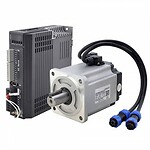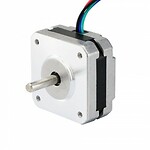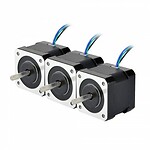The difference between hybrid stepper motor and servo motor
19 augustus 2023 - Independence, Verenigde Staten
A hybrid stepper motor is a discrete motion device that has a low-cost advantage over a servo motor. The motor is a device for converting mechanical and electrical energy. A motor that converts mechanical energy into electrical energy is called a "generator"; A motor that converts electrical energy into mechanical energy is called a "motor". Stepper motors and servo motors are motion control products that can accurately locate the motion trajectory and mode of automation equipment, and are mainly used in the field of automation equipment manufacturing.
According to the classification of stepper motor rotors, there are three types: reactive (VR type), permanent magnet (PM type), and hybrid (HB type).
Reactive (VR type): Gear with rotor teeth. Permanent magnet type (PM type): A rotor with a permanent magnet. Hybrid (HB type): Gear with both permanent magnet and rotor teeth. Classified according to the winding on the stator of stepper motors: there are two phase, three phase, and five equal series. A motor with two stators is called a two-phase motor, and a motor with five stators is called a five-phase motor. The more phases and beats a stepper motor has, the higher its accuracy. Hybrid stepper motors can achieve very precise small incremental step motion, while PM motors generally have low control accuracy requirements.
Hybrid stepper motors can achieve complex and precise linear motion control requirements. Permanent magnet motors have relatively small torque and volume, and generally have low control accuracy requirements, making them more cost-effective. Hybrid stepper motors are mainly used in emerging industries such as photovoltaic power generation and 3D printing; Emerging industries: security monitoring; Traditional industries: textile machinery, food packaging. From the perspective of production process and motor control accuracy, hybrid stepper motors are more high-end than permanent magnet stepper motors.
Both stepper motors and servo motors are motion control products, but there are differences in product performance. A stepper motor is a discrete motion device that executes a step upon receiving a command. The stepper motor converts the input pulse signal into angular displacement. When the stepper motor driver receives a pulse signal, it drives the stepper motor to rotate a fixed angle in the set direction. Servo motor refers to the conversion of electrical signals into torque and speed in a servo system to drive the control object, which can control speed and position accuracy.
Stepping motors and servo motors have significant differences in low-frequency characteristics, torque frequency characteristics, and overload capacity:
control accuracy: the more phases and rows of stepping motors, the higher the accuracy. The control accuracy of AC servo motors is ensured by the rotary encoder at the rear end of the motor shaft, and the more encoder scales, the higher the accuracy.
Low frequency characteristics: stepper motors are prone to low-frequency vibration at low speeds, which is determined by the working principle of the stepper motor and is detrimental to the normal operation of the machine. Damping technology is generally used to overcome low-frequency vibration; The AC servo system has resonance suppression function, which can cover mechanical stiffness deficiencies. The operation is very smooth, and there will be no vibration even at low speeds.
Torque frequency characteristics: The output torque of a stepper motor decreases with increasing speed, so its maximum operating speed is between 300-600 RPM; The servo motor can output rated torque within the rated speed (usually 2000-3000RPM), and constant power output above the rated speed.
Overload capacity: The stepper motor does not have overload capacity; The servo motor has strong overload capacity.
Response performance: It takes 200-400 milliseconds for the stepper motor to accelerate from stationary to working speed (several hundred revolutions per minute); AC servo has better acceleration performance and can be used in control situations that require fast start stop.
Operating performance: The stepper motor is open-loop controlled, and if the starting frequency is too high or the load is too large, it is prone to step loss or rotor blockage. If the speed is too high when stopping, it is prone to overshoot; AC servo adopts closed-loop control, and the driver can directly sample the feedback signal of the motor encoder. Generally, there is no phenomenon of step loss or overshoot of the stepper motor, and the control performance is more reliable.
The application of stepper motors has undergone structural changes, with the traditional market reaching saturation and emerging industries constantly emerging. The company's control motor and drive system products have a deep layout in emerging industries such as medical instruments, service robots, industrial automation, information communication, and security, accounting for a relatively large proportion of the overall business and growing rapidly. The demand for stepper motors is related to the level of economy, technology, industrial automation, and the technological development of stepper motors themselves. In traditional industries such as office automation, digital cameras, and household appliances, the market has reached saturation, while emerging industries are constantly emerging, such as 3D printing, solar power generation,


